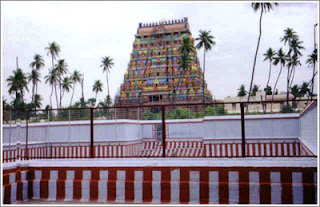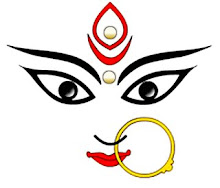On our trip to these two temples.....
Myself and my husband, Ramachandran, together with two of my family friends, left for Trichy early in the morning by about 4.30 am by car. It was a joyous ride through out the journey. My husband, known for his jovial way of keeping the conversation going, and also the two friends, Bhaskar and Shankar, saw to it that we had a pleasant, enjoyable journey right till our return to Chennai. Inspite of the inclement weather prevailing upto Melmaruvathur, we made our way cautiously throughout. As time went by, the weather became sultry and very very hot and humid. Keeping in mind that we had to reach Trichy by 10 am, we did not stop anywhere, except for a small cup of coffee, to refresh ourselves, and by 9.30 am we made it to Trichy.
My friends who accompanied us, had combined this trip with a wedding they had to attend and this being the case, we all headed straight to the marriage hall in Amma Mantapam, Therku Vasal, where the wedding was taking place. Once they made their presence felt at the wedding, we left straight for the Srirangam Temple. Being sunday and knowing that this ancient and famous temple would be crowded, we had already made arrangements with a close collegue of mine, a retired Tasildhar, to helped us around this temple. I should mention here and show my gratitude to this wonderful, simple person, Mr. Sadagopan, who is 80 plus years old, was so influential every where he took us. I should pay my respects to him by saying that he made this temple visit of ours worth every second! We could see all the Gods and Goddesses in all of the sannathis at very close quarters, with the help of our Tasildhar friend, which was very very satisfying for all of us. A memorable visit on the whole, I should say.
Though I have already written about this great temple, a small re-capture of this spectacular Temple for my viewers one more time:
Om Namo Narayanaya
 |
| Srirangam Temple Gopuram |
 |
| Sri Ranganathar, Srirangam |
 |
| Sri Ranganayaki, Srirangam |
The other sannathis in the temple are:
Thayar Sannathi
Chakkarathazwar Sannathi
Udayavar [Ramanujar Sannathi]
Garudalwar Sannathi
Thanvanthiri Sannathi
Hygrevar Sannathi
As I had earlier said, all of the above sannathis were very crowded being sunday. Nevertheless, with the help of our Tasildhar, we could have very good darshan in all of the sannathis. On the whole it was an enjoyable trip to this ancient temple, so rich in its historical importance.
Our next visit was to the Thiruvanai Kovil, Tiruchirappalli only a few kms away from Srirangam Temple.
Thiruvanaikoil is a beautiful small urban village at Tiruchirappalli district in Tamil Nadu of Southern India. Thiruvanaikoil is also familiarly known as Tiruvanaikoil, Tiruvanaikaval.
 |
| Thiruvanaikaval East Side Gopuram |
 |
| Kubera Lingam, Thiruvanaikaval |
 |
| Sri Akilandeswari Amman - Thiruvanaikaval |
The goddess of this temple is 'Akilandeswari' ['Amman']. The Amman is also called as Akilandanyaki. Akilandeswari is pronounced as 'Akilam - Aanda – Eswari' [Akilam – Universe, Aanda – Ruler, Eswari – Goddess]. We were really blessed and fortunate to be at get close quarters in both the sannathis and pray to the Lord and Goddess in a very satisfying manner. The Goddess Akilandeswari was breath-taking in the way the alangaram was done, not to miss Her ears edorned with Chandran and Suryan. The Amman still stands before our eyes in all her glory!
 |
| Temple Archakar dressed like Devi Akilandeswari performing Ko Pujai |
The Legend of the Name - 'Thiru Aanai Kaa'
There were two Siva Ganas [Siva’s disciples who live in Kailash] by name 'Malyavan' and 'Pushpadanta'. Though they are Shiva Ganas they always quarrel with each other and fight for one thing or other. On top of all in one fight 'Malyavan' cursed 'Pushpadanta' to become an elephant in earth and the latter cursed the former to become a spider in earth.
 |
| Legend of the Temple Thiruvanaikaval |
When the elephant saw the web and thought that as dust on Lord Shiva and tore them and cleaned the Linga by pouring water. This happened daily. The spider became angry one day and crawled into the trunk of the elephant and bit the elephant to death killing itself. Lord Siva, moved by the deep devotion of the two relieved them from one other curse.
As an elephant worshipped the Lord here, this place came to be known as 'Thiru Aanai Kaa' [Thiru – Holy, Aanai – Elephant, Kaa [Kaadu] – Forest]. Later the actual name 'Thiruaanaikaa' become 'Thiruvanaikaval' and 'Thiruvanaikoil'.
In the next birth the Spider was born as the King Ko Chengot Chola and built 70 temples and Thiruvanaikoil is the one among them. Remembering his enmity with the elephant in his previous birth, he built the Lord Shiva 'Sannathi'[Sanctorum] such that not even a small elephant can enter. The entrance on the sanctorum of Lord Shiva is only 4 foot high and 2.5 foot wide.
 |
| Lord Jambukeswarar |
Thiruvanaikoil is also called as 'Jambukeswaram' and the Lord as Jambukeswarar, Jambunathan and Jambulingam. The myth behind this is, there was a Sage by name 'Jambu Munivar' [ sage]. He once got a rare and sacred 'Venn Naaval' [Venn – White, White variety of Naaval fruit] fruit and he offered that fruit to Lord Siva. The Lord after eating the fruit spitted the seed. Jambu Munivar took and swallowed the seed, as it is sacred as the seed came from the Lord’s mouth. Immediately a 'Naaval' tree began to grow in the Saint's head. The Saint prayed to Lord Siva that He should take his abode under that tree.
 |
| The Vimanam of Lord Shiva Sanctorum-"Venn Naaval tree" |
As we were all very tried, we decided to stop over for a good refreshing cup of coffee and here, I should mention about the Kumbakonam Degree Coffee Stall by the roadside after Melmaruvathur. Since this Stall was not open as early as 6.30 am in the morning, while we were proceeding towards Trichy, we made up our minds that we should have this tasty "Kappi" atleast on our return...
The coffee and tea offered here is excellent and this small Stall is ever crowded with the passengers passing by, wanting to taste their good "Filter Kappi". To our disappointment, coffee was over for the day[as were were a bit late in coming there], we could however get only to taste the good Tea offered by them. Hats off and good job done to the people running this small shop! Whenever we go on this route, we see to it that we never miss this Coffee Stall! Very tasty " Kumbakonam Filter Kappi"!!
Feeling well refreshed, even though the traffic was heavy while returning, we reached Chennai at around 9pm. It was a good, enjoyable trip to Trichy indeed!






















